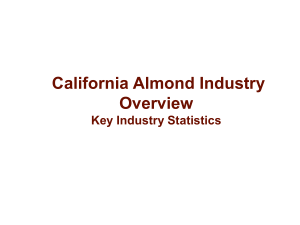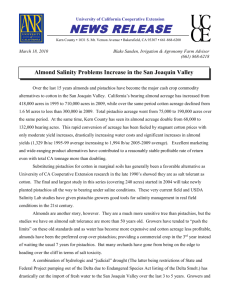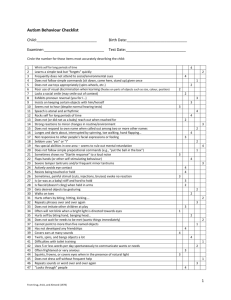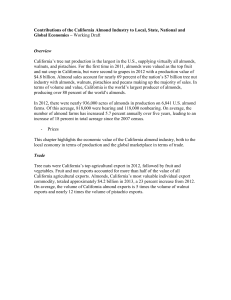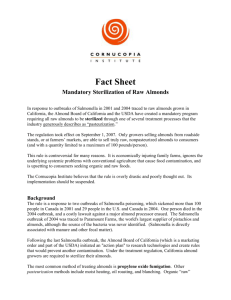Have Expenditures to Advertise California Almonds Been Effective?
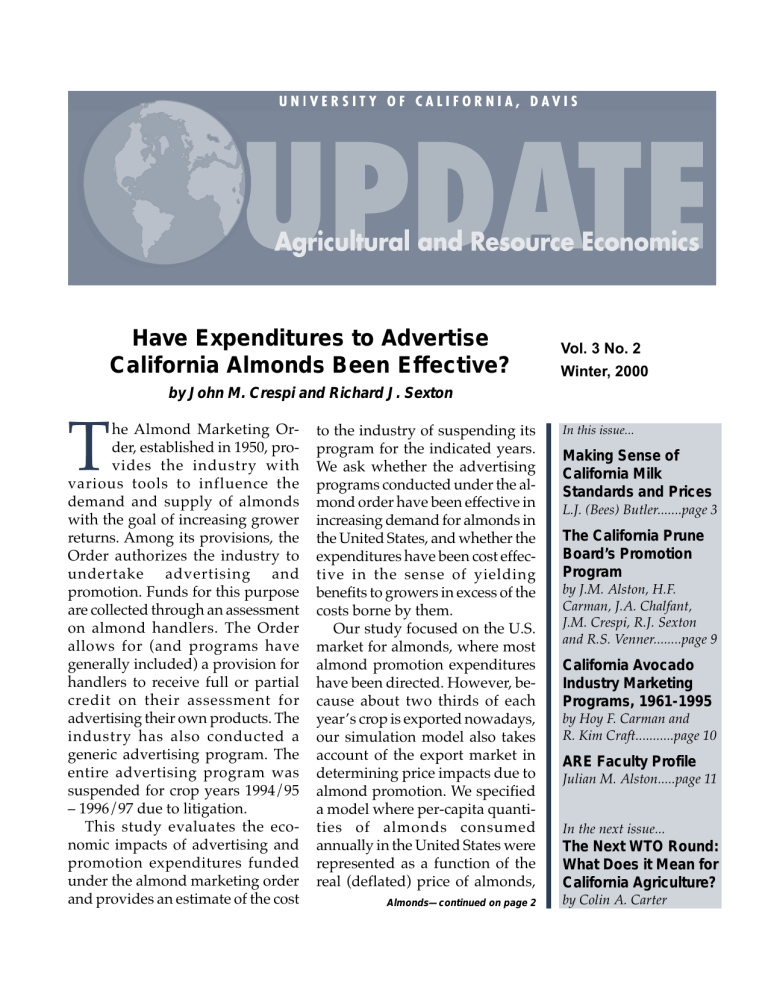
Agricultural and Resource Economics Update
Vol. 3 No. 2 Winter, 2000
Have Expenditures to Advertise
California Almonds Been Effective?
by John M. Crespi and Richard J. Sexton
T he Almond Marketing Order, established in 1950, provides the industry with various tools to influence the demand and supply of almonds with the goal of increasing grower returns. Among its provisions, the
Order authorizes the industry to undertake advertising and promotion. Funds for this purpose are collected through an assessment on almond handlers. The Order allows for (and programs have generally included) a provision for handlers to receive full or partial credit on their assessment for advertising their own products. The industry has also conducted a generic advertising program. The entire advertising program was suspended for crop years 1994/95
– 1996/97 due to litigation.
This study evaluates the economic impacts of advertising and promotion expenditures funded under the almond marketing order and provides an estimate of the cost to the industry of suspending its program for the indicated years.
We ask whether the advertising programs conducted under the almond order have been effective in increasing demand for almonds in the United States, and whether the expenditures have been cost effective in the sense of yielding benefits to growers in excess of the costs borne by them.
Our study focused on the U.S.
market for almonds, where most almond promotion expenditures have been directed. However, because about two thirds of each year’s crop is exported nowadays, our simulation model also takes account of the export market in determining price impacts due to almond promotion. We specified a model where per-capita quantities of almonds consumed annually in the United States were represented as a function of the real (deflated) price of almonds,
Almonds—continued on page 2
Vol. 3 No. 2
Winter, 2000
In this issue...
Making Sense of
California Milk
Standards and Prices
L.J. (Bees) Butler.......page 3
The California Prune
Board’s Promotion
Program by J.M. Alston, H.F.
Carman, J.A. Chalfant,
J.M. Crespi, R.J. Sexton and R.S. Venner........page 9
California Avocado
Industry Marketing
Programs, 1961-1995 by Hoy F. Carman and
R. Kim Craft...........page 10
ARE Faculty Profile
Julian M. Alston.....page 11
In the next issue...
The Next WTO Round:
What Does it Mean for
California Agriculture?
by Colin A. Carter
1
Agricultural and Resource Economics Update
Figure 1. U.S. Per-capita Annual Almond Consumption –
Actual versus Fitted Values, 1962/63-1997/98
1.2
Pounds per person
1
0.8
0.6
0.4
0.2
Actual Predicted
0
62 64 66 68 70 72 74 76 78 80 82 84 86 88 90 92 94 96 98 real consumer income, and the real annual expenditure on almond promotion.
An increase in the price of almonds should lead to a decrease in almond consumption, while an increase in total money income should lead to an increase in almond consumption . Successful promotions will increase demand, but unsuccessful promotions will have little or no effect on demand.
Data for the model consisted of 36 annual observations for crop years 1962/63 through 1997/98.
Promotion expenditures consisted of the sum of the amounts spent on advertising by the Almond Board of California (ABC) and Blue Diamond Growers
(BDG), the leading marketer and dominant advertiser of almonds in the industry. For most of the time period we studied, almond handlers like BDG were allowed to satisfy at least a portion of their promotional assessment by advertising their own products.
Thus, promotion funded under the auspices of the almond order appropriately includes the amount of assessments credited to BDG and other handlers for the purposes of advertising their own products.
The estimated model explained about 85 percent of variation in almond consumption from 1962/63 –
1997/98. Figure 1 compares actual U.S. per-capita almond consumption with consumption predicted by the model for the 1962/63 – 1997/98 crop years. The elasticity of demand with respect to price evaluated at the means of the sample was estimated to be about –
0.7, implying that a 10 percent increase in the price of almonds results in a 7 percent decrease in almond consumption. The elasticity of demand with respect to promotion expenditures was estimated to be 0.13, indicating that a ten percent increase in annual promotion expenditures results in a 1.3 percent increase in almond consumption. Finally, the estimate of the elasticity of demand with respect to income was about 0.7, indicating that consumption increases with an increase in consumer income, but the increase is less than proportional.
Simulation Model and Benefit-Cost Analysis
The estimated model of U.S. demand for almonds was used to measure the gross and net benefits to the
California almond industry from its expenditures on promotion. The demand model provides an estimate of how quantities of almonds sold in the U.S. increase in response to a given increase in promotional expenditures, holding prices and other variables constant.
However, the increase in price following a promotioninduced shift in demand is an important source of the benefits from almond advertising. To evaluate the effects of almond promotion properly, we must combine the estimated demand model with a model of the supply of almonds to the U.S. market.
The diagram in figure 2 (on page 7) illustrates the supply and demand relationships for a typical year.
The curve labeled S represents the residual supply curve for almonds to the domestic (U.S.) market. At higher prices more almonds are available domestically, while at lower prices, larger quantities of almonds are diverted to the export market. The curve labeled D
1 represents the demand curve—at higher prices, consumers purchase a smaller quantity of almonds than at lower prices, holding promotion expenditures and other factors constant. The market equilibrium occurs at point E . The market price adjusts until the quantity demanded and the quantity supplied are equated at price P .
ALMONDS —continued on page 7
2
Agricultural and Resource Economics Update
Almonds —continued from page 2 effect of an increase in promotion is illustrated by the outward shift in the demand curve to D
2
. The demand model allows us to estimate the horizontal distance of the demand shift in the U.S. market needed to bring forth the additional quantities to the
U.S. market to satisfy the increased demand. Second, an increase in assessments is needed to pay for the additional promotion expenditures. This cost has the effect of shifting demand down by the amount of the additional per-unit assessment—the curve D
3
in Figure 2. The new equilibrium is represented by the point E’, where D
3
intersects S . Price and quantity both increase to P’ and Q’ .
To generate a model of the supply of almonds to the U.S. market, we begin by noting that newly planted almond trees do
Fig 2. Conceptual Supply and Demand Model
Price
($/lb.)
P’
P not begin bearing for three to four years.
Harvest is determined primarily by yield of the bearing acreage, which is a function of weather conditions and is largely unaffected by the current year ’s price. Thus, within this time frame price has essentially no effect on total supply. We chose to examine the promotion program over a recent four-year period so that
0
S
Q
E
Q’
E’
D
1
D
3
S
D
2
Quantity (lbs./year) we could treat bearing acreage as fixed and total harvest as unaffected by the current market price.
The supply of almonds to the U.S. market in a given year consists of total supply (harvest + carry in) minus the amount that would be exported at various prices. We calibrated residual supply curves for the
U.S. market using estimates of the export demand for almonds provided in an earlier study of the industry by researchers from the ARE Department. We used a range of choices for this elasticity (0.86, 1.50, and 2.56) to examine the degree to which our results are sensitive to choices of this parameter, where, admittedly, our knowledge is less than precise.
By equating supply and demand and solving for market equilibrium, we obtained values of actual prices and predicted quantities. We then simulated counterfactual scenarios using a hypothetical, marginal increase in the amount of promotion and associated assessment in each year for 1990/91 to
1993/94 of 1.10 times the actual amount of promotion.
Because the program was suspended due to litigation from 1994/95 through 1996/97, the 1990/91 – 1993/
94 period represented the most recent four years of promotion activity that were in some sense “normal” from the industry’s perspective. The differences between the actual and counterfactual scenarios were then used to calculate measures of the marginal net benefits to producers from the joint increase in promotion expenditures and assessments.
For our lower bound, residual supply elasticity of
0.86, the benefit-cost ratio for a ten-percent increase in promotional expenditure was estimated to be 6.88, i.e., a marginal dollar expended on promotion yields a return to growers of $6.88. As the supply elasticity rises, producers receive progressively smaller benefits from a given demand increase because price rises less for a given demand shift. Hence, the benefit-cost ratio falls from 6.88 to 4.51 when the midrange elasticity of 1.5 is used, and finally to 2.87 when the upper bound of the residual supply elasticity of 2.56 is used.
Financial Impacts from the
Promotion Program’s Suspension
Suspension of the industry’s promotion program from 1994/95 through 1996/97 provides a natural experiment for assessing the impact of the absence of advertising on the almond industry. For the three years before the suspension period, the average, effective assessment was $0.02091 per pound (kernel weight).
Using this assessment rate with the harvests for the
1994/95 through 1996/97 period would have resulted in the following levels of promotion: $15.3 million in
1994/95, $7.7 million in 1995/96, and $10.6 million in
7
Agricultural and Resource Economics Update
1996/97. Actual promotion levels were $5.3 million,
$4.2 million, and $2.2 million, respectively. Using these counterfactual estimates of promotion and the corresponding assessment rate for the years 1994/95 through 1996/97 in the market equilibrium model allows us to compare estimates of growers’ profit obtained using the actual promotion levels and assessments with those obtained under the counterfactual levels.
Table 1 summarizes the results. The accumulated loss from the suspension of the promotion program is estimated to be between 89.62 and 234.21 million dollars, depending upon the value chosen for the residual supply elasticity. These estimates are profit (not just revenue) losses since the costs of the increased promotion are already accounted for in the model.
Conclusion
The results of the analysis indicate that almond promotion has been a highly effective tool in stimulating almond demand and increasing producer profits. A best guess is that marginal dollars expended promoting almonds have yielded a return to producers in the range of 3:1 to 7:1. Of course, these rates of return are very favorable when compared to returns available to other investments. Given the specifications used in this study, the average return on investments in almond promotion is necessarily higher than the marginal returns.
Suppose, for example, that a 10 percent rate of return on investment is normal. Then any producer benefit-cost ratio in excess of 1.1:1 indicates a profitable expenditure of funds at the margin. In fact, to maximize its return from investments in almond promotion, the industry should expand promotion efforts to the point where the marginal expenditure on promotion just yields a return comparable to that available on investments elsewhere. The evidence suggests quite strongly, therefore, that the industry has spent too little on promotion over the time period analyzed here. Thus it was unfortunate from the industry’s perspective that expenditures were curtailed from 1994/95 through
1996/97 due to litigation. We estimate that suspension of the advertising program cost the industry accumulated profits in the range of 90 to 234 million dollars during the period of the suspension.
John Crespi is a Ph.D. candidate in the ARE department at UC
Davis. His interests include commodity promotion. John can be reached by phone at (530)752-2092 or by e-mail at: crespi@primal.ucdavis.edu. Richard Sexton is a professor in the
ARE deparment with interests in agricultural marketing and trade, economics of cooperatives, and industrial organization. Dr. Sexton can be contacted by phone at (530)752-4428 or by e-mail at sexton@primal.ucdavis.edu.
Crop
Years
1994/95
1995/96
1996/97
1994/95
1995/96
1996/97
1994/95
1995/96
1996/97
Table 1. Actual and Counterfactual Prices and Grower Profits for 1994/95 to 1996/97
Actual
Prices
($/lb.)
1.47
2.65
2.14
1.47
2.65
2.14
1.47
2.65
2.14
Counterfactual
Prices
($/lb.)
Actual
Profits
($ millions)
U.S. Residual Elasticity = 0.86
1.61
2.76
2.37
Total
1,075.01
966.81
1,083.41
3,125.23
U.S. Residual Elasticity = 1.50
1.56
2.73
2.30
Total
1,075.01
966.81
1,083.41
3,125.23
U.S. Residual Elasticity = 2.56
1.53
2.71
2.24
Total
1,075.01
966.81
1,083.41
3,125.23
Counterfactual
Profits
($ millions)
1,166.54
1,003.35
1,189.55
3,359.44
1,130.04
992.16
1,153.25
3,275.45
1,105.72
983.01
1,126.12
3,214.85
Profit
Reduction
($millions)
91.53
36.54
106.14
234.21
55.04
25.35
69.85
150.24
30.71
16.20
42.71
89.62
8
